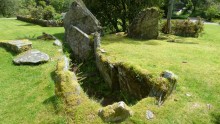|
|
|
|
Crarae GardenChambered Cairn
|
||||||||||||||||||||||||
|
|
|
News |
|
Neolithic Scots prefered steak to seafoodhttp://www.theherald.co.uk/news/archive/13-2-19103-0-27-44.html John McEarchran - The Herald PREHISTORIC Scots snubbed the seafood which has since become world famous, it was revealed yesterday in the results of tests on 5500-year-old human bones... continues... |
 Posted by Rhiannon
Posted by Rhiannon13th February 2003ce |
Images (click to view fullsize) |
|
Photographs:











 Maps / Plans / Diagrams:
Maps / Plans / Diagrams:
|
Fieldnotes |
|
|
A pleasant surprise to find this tomb while having a look around the gardens. Manicured yes, but equally in no danger of being ploughed up, or having rubbish dumped in it, so I'll take what I can get. It's not worth paying the entrance fee to see it, and in some respects nor are the gardens given what NTS charge. I'd always advise joining, because no matter what your views on the organisation, you get 'free' entry to all the properties, throughout the UK. Nice places for picnics on the way home, and for finding hidden gems like this one. |
 Posted by Chris
Posted by Chris2nd August 2007ce |
|
This is a good example of a Clyde chambered cairn. It is situated in the National Trust for Scotland's Crarae Gardens which has its good and bad points. On the positive side, it is well cared for even if it is a little over-manicured for my tastes. On the negative side, if you arrive between 10 and 5 from April to October, you may be asked to pay the £5 entrance fee. Outside these times there is an honesty box and the gardens are open dawn to dusk all year round. Interesting features at this cairn are: the flat facade; the size of the orthostats on the facade; the dry stone walling (reconstructed). More details with the photo captions. This is a site which many will pass on the road to Kilmartin and it's well worth stopping to have a look at if your schedule permits. The gardens are well signposted off the A83, north of Minard. Visited 24 March 2004 |
 Posted by greywether
Posted by greywether30th March 2004ce Edited 30th March 2004ce |
Folklore |
|
|
East of the chambered cairn is a round cairn, known as the Fairy Knowe, due to its one-time? otherworldly inhabitants. (Grinsell - 'Folklore of Prehistoric Sites in Britain') |
 Posted by Rhiannon
Posted by Rhiannon22nd June 2004ce Edited 22nd June 2004ce |
Links |
|
PSAS 9431 page excavation report - PDF file |
 Posted by greywether
Posted by greywether5th September 2004ce |
Martin Powell's Prehistoric Sites in ScotlandA picture of the cairn on this site - with the rather strange statement that: "During excavation in 1963, some 5,000 seashell remains were found in the chamber, representing 15 different species. All had been eaten." I'm not sure how you know if a long deposited seashell had been used for food or not. But more interestingly, why were the shells in the cairn chamber? Did the seashells had some other significance than food? or were they for the dead to eat? Or was the chamber just being used as a shell tip (surely not?) |
 Posted by Rhiannon
Posted by Rhiannon13th February 2003ce Edited 22nd June 2004ce |

